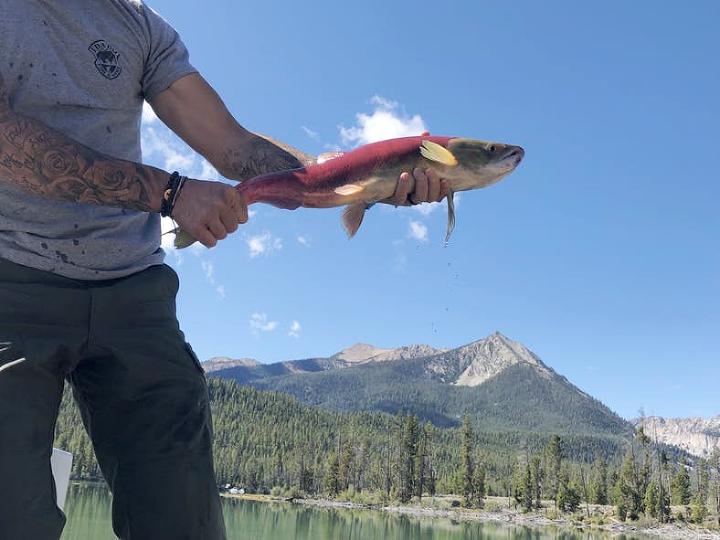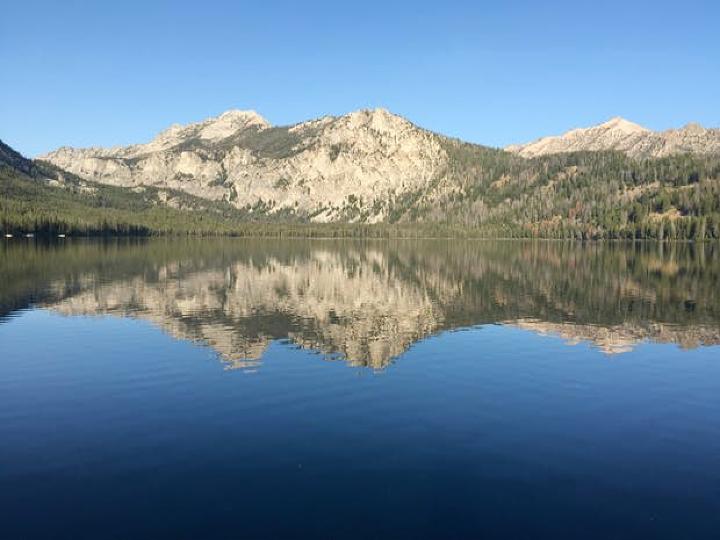 |
Canku Ota
|
 |
|
(Many Paths)
|
||
|
An Online Newsletter
Celebrating Native America
|
||
|
DECemBER 2020 - Volume
18 Number 12
|
||
|
|
||
|
Return Of Idaho's
Sockeye Salmon
|
||
|
by Mark Trahant - Indian
Country Today
|
||
The Shoshone-Bannock Tribes" years of effort on the recovery plan is paying off Let"s break a few journalism rules. I am writing about my own tribe. It"s a subject I care deeply about, salmon recovery. And my brother turns out to be one of my sources. Other than that, I can be objective. But I am burying the lede: After two decades of litigation, mitigation and field preparation, the sockeye salmon showed a promising return this year to Idaho"s Pettit Lake near Stanley, Idaho. The thing is, a lot of people have given up on the Snake River sockeye. The challenges are enormous. Sockeye travel the farthest of all Idaho salmon, a journey of more than 900 miles and climbing more than 6,500 feet in elevation before they reach the Sawtooth Valley. The fish are not as big (or as popular) as the king salmon or steelhead. There"s not much in the way of sports fishing or commercial fishing. Basically we"re talking about a salmon stepchild. The Shoshone-Bannock Tribes have treaty rights to fish for salmon, and because the sockeye is so rare, few people have seen one in three decades. "It doesn"t get all the attention that the chinook, the king"s, the big salmon and steelhead get," says Kurt Tardy, an anadromous fisheries biologist for the Shoshone Bannock Tribes. One reason is the states make zero from that species so there is not a lot of reason to put money into recovery. But it is an iconic fish. Idaho"s Redfish Lake is named for the sockeye, the reds."It's a species that it's important to the planet and important, especially if you're a tribal member," Tardy said. "We haven't had sockeye returned to Pettit Lake in over 30 years. So however you draw the straw, you could have the short one or the long one, that's success in itself. Bottom line, period, we actually have fish returning from the ocean that have Pettit origin genes." This is a big deal. If you read the headlines from Idaho and sockeye there are lots of stories about the species" decline. "Will sockeye salmon survive in Idaho?" asks the Idaho State Journal. One projected run of 800 fish ended up at 27 fish. "The bottom line here is, among other things, that the fish have a dam problem." That"s the eight federal dams between the mountains of central Idaho and the Pacific Ocean. In 1999, the Shoshone-Bannock Tribes filed a petition with the National Marine Fisheries Service to list the sockeye as an endangered species in order to launch a recovery plan. The tribes have actively worked since then on that restoration.Robert Trahant has worked on the project since 1995. "So this is remarkable for me to see progress after 20 years, 25 years." "Rob has seen a slew of different things that the sockeye program has done," Tardy said. "So he was at the beginning (and) instrumental in egg releases. So first we used to do egg box releases." Those produced several thousand small fish each year, but the few made their way back to the spawning grounds from the ocean. And no fish returned to Pettit Lake. That"s the challenge: Using the best science to get fish past the dams and to create a new natural cycle of migration with fish that have a Pettit Lake genetic mark. "Ultimately moving forward is to regenerate, recreate, repopulate, recolonize, a fish in this case, Sockeye that are specific to Pettit Lake," Tardy says. Much of the focus on Idaho"s sockeye is on Redfish Lake. But that lake is overpopulated. And if the goal is eventually a tribal fishery that would be "impossible" where there are so many people.
And Tardy said the sockeye plan is for healthy sockeye in Redfish, Pettit and Alturas lakes. "Pettit is kind of marked as the first non-Redfish Lake to receive much of the attention," Tardy said. "Once Redfish is operational, once Pettit is basically trending towards recovery, then we could look to other lakes … that historically had sockeye salmon in them." This year"s return was a surprise. The Shoshone-Bannock Tribes fishery team learned of the returning fish from Elizabeth Paul, working with the Idaho Salmon Partnership. She sent word about a tagged fish. "I hate to say it, but we did not know that at the time," Tardy said. "Once we knew that there was one fish returning, we were able to extrapolate. So basically on our tagging rate, knowing that one is returning, we were able to extrapolate and we anticipated around 20 fish that would return to Pettit Lake. And science isn't always accurate … so we ended up returning 38, which was very good, right?" "I probably will never be able to fish for a sockeye," Trahant said. "Well, hopefully my kids will, my grandkids, and future families will be able to have that fishery and that cultural aspect" of sockeye again.
Mark Trahant, Shoshone-Bannock, is editor of Indian Country Today. On Twitter: @TrahantReports Trahant is based in Phoenix. |
||||
|
|
|
|
||
|
|
||
| Canku Ota is a free Newsletter celebrating Native America, its traditions and accomplishments . We do not provide subscriber or visitor names to anyone. Some articles presented in Canku Ota may contain copyright material. We have received appropriate permissions for republishing any articles. Material appearing here is distributed without profit or monetary gain to those who have expressed an interest. This is in accordance with Title 17 U.S.C. Section 107. | ||
|
Canku Ota is a copyright ©
2000 - 2020 of Vicki Williams Barry and Paul Barry.
|
||
 |
 |
|
|
The "Canku
Ota - A Newsletter Celebrating Native America" web site and
its design is the
|
||
|
Copyright ©
1999 - 2020 of Paul C. Barry.
|
||
|
All Rights Reserved.
|
||

